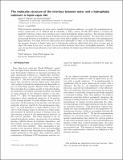The molecular structure of the interface between water and a hydrophobic substrate is liquid-vapor like
Author(s)
Willard, Adam P.; Chandler, David
Downloadlambda.pdf (3.301Mb)
OPEN_ACCESS_POLICY
Open Access Policy
Creative Commons Attribution-Noncommercial-Share Alike
Terms of use
Metadata
Show full item recordAbstract
With molecular simulation for water and a tunable hydrophobic substrate, we apply the instantaneous interface construction [A. P. Willard and D. Chandler, “Instantaneous liquid interfaces,” J. Phys. Chem. B114, 1954–1958 (2010)] to examine the similarity between a water-vapor interface and a water-hydrophobic surface interface. We show that attractive interactions between a hydrophobic surface and water affect capillary wave fluctuations of the instantaneous liquid interface, but these attractive interactions have essentially no effect on the intrinsic interface. The intrinsic interface refers to molecular structure in terms of distances from the instantaneous interface. Further, the intrinsic interface of liquid water and a hydrophobic substrate differs little from that of water and its vapor. The same is not true, we show, for an interface between water and a hydrophilic substrate. In that case, strong directional substrate-water interactions disrupt the liquid-vapor-like interfacial hydrogen bonding network.
Date issued
2014-10Department
Massachusetts Institute of Technology. Department of ChemistryJournal
The Journal of Chemical Physics
Publisher
American Institute of Physics (AIP)
Citation
Willard, Adam P., and David Chandler. “The Molecular Structure of the Interface Between Water and a Hydrophobic Substrate Is Liquid-Vapor Like.” The Journal of Chemical Physics 141, no. 18 (November 14, 2014): 18C519.
Version: Author's final manuscript
ISSN
0021-9606
1089-7690